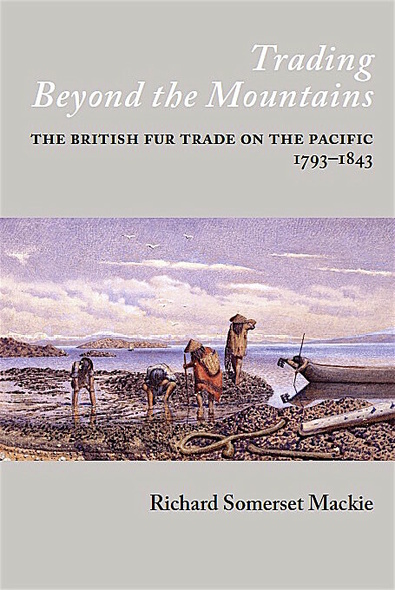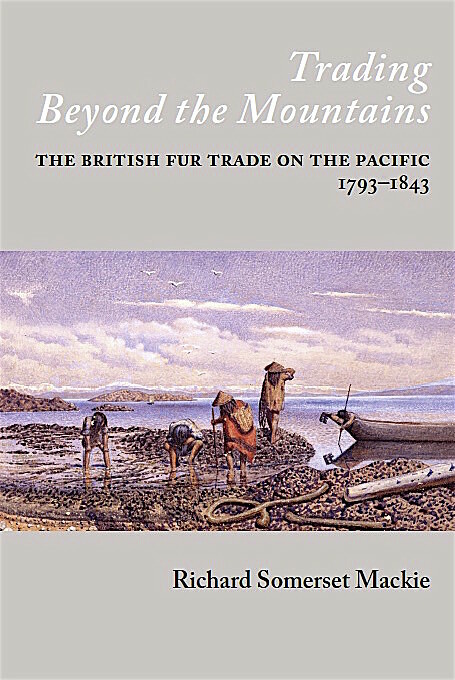
Trading Beyond the Mountains
The British Fur Trade on the Pacific, 1793-1843
During the late eighteenth and early nineteenth centuries, the North West and Hudson’s Bay companies extended their operations west beyond the Rocky Mountains, constructing forts and farms throughout the western Cordillera and on the Pacific Coast. There they encountered a mild and forgiving climate, abundant natural resources, year-round ocean-going transport, and Indigenous societies that provided local sources of knowledge, trade, and labour. Trading Beyond the Mountains charts what fur traders called the "extension of the trade" to these new western regions between 1793 and the establishment of Fort Victoria in 1843. On the lower Columbia and lower Fraser rivers, and on Puget Sound, conditions were ideal for fur trade companies to move "beyond the mere trade in peltries": relying on Indigenous trade and labour they branched out into farming, fishing, and logging, bringing economic diversification to this westernmost fur trade district and transforming it into a dynamic and distinctive regional economy.
By 1843, the Hudson’s Bay Company had opened agencies in Oahu (Hawaii), Sitka (Russian America), and Yerba Buena (California) to sell Pacific coast products including salmon, lumber, and flour. Most such exports depended on Indigenous work or trade. Richard Somerset Mackie shows how economic relations between fur traders and Indigenous people consisted of countless small, physical, and mundane acts of trade – for provisions, for pelts, and for commodities destined for export to new Pacific markets. These small acts of trade came to dominate relations between Indigenous people and resident employees of the Northwest and Hudson’s Bay companies.
Awards
- 1997, Winner - Medal for Historical Writing, Lieutenant Governer
This [is] exceptionally well documented history.
Richard Mackie’s Trading Beyond the Mountains is a milestone study of the Hudson’s Bay Company. It is a fresh approach to an old subject and is based in thoroughly modern research. It should be read by anyone interested in the history of the fur trade or the early history of the Canadian or American West.
Mackie covers his selected topic in an engaging, highly readable, and beautifully illustrated book … This is a welcome addition to the literature of commercial policy and history of the Pacific west coast.
This solid, narrative-based historical geography should become the standard bearer on the origins and evolution of the eighteenth- and nineteenth century British fur trade in the Pacific Northwest.
Fluently written, abundantly documented, and supplemented with numerous informative and beautifully crafted maps, Mackie’s portrayal of the Hudson’s Bay Company’s dynamic and multifaceted Pacific economy leaves a strong impression…
...an excellent and readable book [that] belongs in the library of every historian and historical geographer with interest in western North America.
The book [Trading Beyond the Mountains] is a magisterial history of commerce … The interpretation is illuminating, and accordingly, every student of the northeast Pacific’s history should read this book.
Richard Mackie has made an important contribution, and this work is an essential acquisition for the libraries of scholars with an interest in the maritime fur trade, the Hudson’s Bay Company, and the region.
Trading Beyond the Mountains breaks new ground in documenting the scale and diversity of commercial operations by the Hudson’s Bay Company.
This book will prove extremely useful for anyone seeking information on the HBC’s business in the western part of its territory.
This book is an important contribution to western historiography, and it will have a long shelf life as a reference work.
This book is an original account, splendidly researched, of a neglected period in west coast economic history.
An exemplary study – thoroughly researched, clearly written, and voluminous…
A fascinating look at the history of economic development in the Pacific Northwest.
This well-timed narrative provides the first clear account not only of the economic origins of British Columbia but also of the maritime adventures of what had become the largest private landowner in the world
Trading Beyond the Mountains is a thoroughly researched and comprehensive history of five decades of the fur trade … clearly written and well documented …. an excellent resource for students and those interested in the fur trade.
Trading Beyond the Mountains provides a long overdue examination of the activities of the NWC and HBC as they expanded into territories lying west of the Rocky Mountains.
The author weaves a detailed account of the scale and scope of the Hudson’s Bay Company’s diverse commercial operations in the region and the expansion of their activities along the Pacific coast of North America.
This is not simply a history of the fur trade. Mackie presents a picture of the HBC as a dynamic, flexible commercial enterprise, devising strategies to defeat American competitors and expand trade into new commodities and new areas … The book is a valuable addition to scholarship.
Mackie produce[s] a well-balanced and orderly account of the British fur trade across a huge area of the North American continent.
What role did Natives play in the Company’s commerce? Recognizing the existence of a Native exchange system featuring haiqua (shells) and slaves, Mackie sees the Company as committed to fitting into it.
Trading Beyond the Mountains ... includes an important chapter on Native peoples’ (including slaves’) fundamental role in labour and trade practices.
Trading Beyond the Mountains is a significant contribution to the emerging national meta-narrative.
Over these five decades, Mackie argues that the economic development of the region was dramatic: in 1793 commerce consisted primarily of a riverine fur trade; by 1843 the region possessed the rudimentary elements of a commercial economy, including established trade routes, export trades, local markets, and a large and cheap labour supply.
Trading Beyond the Mountains … will hopefully initiate a much-needed reevaluation of the role played by the Hudson’s Bay Company in the history of Western North America.
Mackie has delved into obscure and little-known documents to produce a comprehensive study of an unknown period of our history.
Trading Beyond the Mountains is meticulously researched and annotated, and supported with maps, tables and a massive bibliography of primary and secondary materials, published and unpublished.
By 1840 the company had developed an integrated commercial economy in this huge area and had virtually destroyed American competition. Individual American trappers and traders could not match HBC capital and organization.
Trading Beyond the Mountains is an overview of the development and expansion of trade by the Hudson’s Bay Company before the establishment of Fort Victoria. Well written and well researched, it is not a history of forts and people, but of HBC policy in the Columbia District and the evolution of its non fur-trade enterprises such as lumber and salmon-fishing.
Using complex data from Company records, and extensive unpublished correspondence, as well as reports, contemporary accounts, and unpublished memoirs, Mackie takes us on an in-depth historical tour of the Columbia Department’s multifaceted Pacific Coast operations. We are introduced to the fur trade, the overland transportation and trade system, the coastal carrying trade, and a wide variety of economic activities literally ‘beyond the fur trade’ that gave the Hudson’s Bay Company economic diversification in an age of staple dependencies ... No study to date has provided such depth.
Figures, Maps, and Tables
Acknowledgments
Introduction
1 The North West Passage by Land
2 Managing a New Region
3 George Simpson and a New Pacific Commerce
4 Nature Here Demands Attention
5 From Fort Vancouver to the Vermilion Sea
6 The North West Coast
7 New Markets for New Exports
8 Columbia Country Produce
9 Beyond the Mere Traffic in Peltries
10 Crisis in the Fur Trade
11 Simpson's Reorganization
12 The Native Foundation of Trade and Labour
Conclusion
Notes
Bibliography
Index




